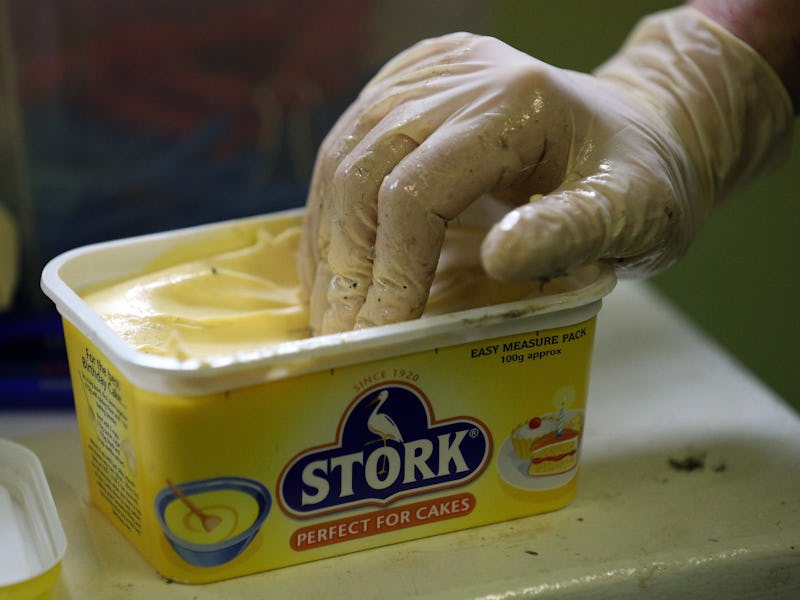Remembering America's Bizarre War on Margarine
I Can't Believe It's Not ... still a felony.

In 1885, Wisconsin Representative — and future Progressive Party icon — Robert M. La Follette along with other lawmakers from states across the Midwest gave a series of impassioned speeches to Congress. They implored their colleagues to act against a substance so vile, so deleterious, it was slowly destroying American families. What was this foul chemical, drug, or poison, borne out of “the ingenuity of depraved human genius,” that could so shred the country’s very fabric?
Margarine. That scoundrel.
“It is made to look like something it’s not; to sell for something it is not, and so deceive the purchaser. It follows faithfully two rules: ‘Miss no opportunity to deceive’; ‘At all times put money in thy purse,’” La Follette declared. “Oleomargarine is a monstrous product of greed and hypocrisy.”
The War on Margarine became one of the most contentious political issues of its day. Political cartoons and opinion columns began appearing in newspapers nationwide extolling the virtues of “sweet and wholesome” butter. Scientific journals (some legit, some of a much more dubious stripe) published article after article extolling the virtues of natural butter while claiming that margarine was produced from meat not fit to hit the market and could potentially cause cancer or even insanity. (Like your dad, science has never really stopped grilling butter.) The Daily Northwestern, a newspaper published in Oshkosh, went so far as to publish a how-to guide to identify and apprehend “margarine moonshiners.”
Pro-butter members of the U.S. House of Representatives crafted a bill that would have in effect taxed the entire margarine industry out of existence. And while the bill was subsequently watered down on its way to being signed into law by President Grover Cleveland, the Federal Margarine Act of 1886 imposed a $0.02 per pound tax (increased to almost 5 times that amount in 1902), and required all margarine manufacturers, wholesalers, and retailers to pay steep fees for annual margarine licenses.
States that counted dairy products among their main exports took the fight even further, tacking on steep state taxes and licensing fees on top of the federal penalties. For a time, Wisconsin and six other states barred the sale and manufacture of margarine completely. Even after the margarine ban was found to be unconstitutional, states mandated that margarine had to be clearly labeled (an early precursor to today’s food-labeling laws) as an oleomargarine product.
And just to make sure margarine buyers knew they weren’t getting the “genuine article,” some states either banned margarine manufactures from adding yellow dye (in Wisconsin, selling yellow margarine remained a crime punishable by jail time until 1967), or mandated that all margarine products be dyed with alternative colors: red, brown, black, or most interestingly, bright pink.
Pro-margarine groups hit back, accusing anti-margarine crusaders of using the laws as an elitist tool to protect the lucrative dairy industry and undermine the free market. Anti-poverty advocacy groups soon joined the fight as rising butter prices (before federal and state taxes, margarine sold for about half the price of butter) and the onset of the Great Depression meant margarine was the only feasible alternative for many American families. Butter at that time was considered an important and necessary part of people’s diets; you may rightly still consider it as much.
If not for two key developments in the late 1940s margarine might still be barred from grocery shelves. First, margarine manufactures were able to strike down parts of the “pink laws” regarding the use of food coloring: while yellow dye couldn’t be added in states with prohibitive laws, coloring could be added at the time of manufacture and transported across state lines.
Second, margarine, which was originally made from chemically treated animal fats (ewwwwww), began to be produced solely from hydrogenated vegetable oils. Not only did this make the product more palatable for those with more squeamish constitutions, but it converted farmers, various agriculture lobbying groups, and many politicians from states with soy and corn industries into avid margarine supporters.
Subsequently, the margarine industry exploded. From the late 1960s till the late 2000s, Americans’ consumption of margarine was twice that of butter. Yet history repeats itself, and as society has shifted its health worries from calorie counts generally to trans fats specifically, good ol’ natural butter has slowly regained its rightful spot as the spreadable dairy condiment king.
On a much smaller, infinitely less entertaining scale, the butter vs. margarine debate continues. But before you toss that tub of pumpkin spice Country Crock into your shopping basket, take a moment to reflect on how your great-grands had to live through the Oshkosh version of Boardwalk Empire so you could enjoy your faux-buttery freedoms.